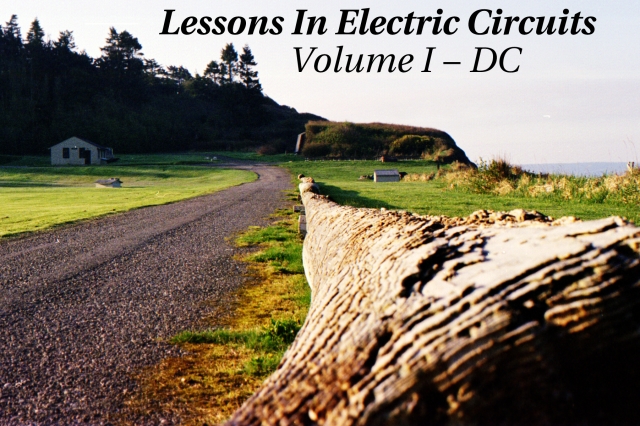This amazing book about basic electrical and electronics engineering was written by Tony R. Kuphaldt and it was released under the Design Science License . These terms and conditions allow for free copying, distribution, and/or modification of this document by the general public. After that this book has been updated by numerous contributors.
Master Index
Chapter 1: BASIC CONCEPTS OF ELECTRICITY
1.1: Static Electricity
1.2: Conductors, Insulators, and Electron Flow
1.3: What Are Electric Circuits?
1.4: Voltage And Current
1.5: Resistance
1.6: Voltage and Current in a Practical Circuit
1.7: Conventional Versus Electron Flow
Chapter 2: OHM’S LAW
2.1 Ohm’s Law – How Voltage, Current, and Resistance Relate
2.2 An Analogy for Ohm’s Law
2.3 Power in Electric Circuits
2.4 Calculating Electric Power
2.5 Resistors
2.6 Nonlinear Conduction
2.7 Circuit Wiring
2.8 Polarity of voltage drops
2.9 Computer Simulation of Electric Circuits
Chapter 3: ELECTRICAL SAFETY
3.1 The Importance of Electrical Safety
3.2 Physiological Effects of Electricity
3.3 Shock Current Path
3.4 Ohm’s Law (again!)
3.5 Safe Practices
3.6 Emergency Response
3.7 Common Sources of Hazard
3.8 Safe Circuit Design
3.9 Safe Meter Usage
3.10 Electric Shock Data
Chapter 4: SCIENTIFIC NOTATION AND METRIC PREFIXES
4.1 Scientific Notation
4.2 Arithmetic with Scientific Notation
4.3 Metric Notation
4.4 Metric Prefix Conversions
4.5 Hand Calculator Use
4.6 Scientific Notation in SPICE
Chapter 5: SERIES AND PARALLEL CIRCUITS
5.1 What are “Series” and “Parallel” Circuits?
5.2 Simple Series Circuits
5.3 Simple Parallel Circuits
5.4 Conductance
5.5 Power Calculations
5.6 Correct use of Ohm’s Law
5.7 Component Failure Analysis
5.8 Building Simple Resistor Circuits
Chapter 6: DIVIDER CIRCUITS AND KIRCHHOFF’S LAWS
6.1 Voltage Divider Circuits
6.2 Kirchhoff’s Voltage Law (KVL)
6.3 Current Divider Circuits and the Current Divider Formula
6.4 Kirchhoff’s Current Law (KCL)
Chapter 7: SERIES-PARALLEL COMBINATION CIRCUITS
7.1 What is a Series-Parallel Circuit?
7.2 Analysis Techniques for Series Parallel Resistor Circuits
7.3 Re-drawing Complex Schematics
7.4 Component Failure Analysis (Continued)
7.5 Building Series-Parallel Resistor Circuits
Chapter 8: DC METERING CIRCUITS
8.1 What is a Meter?
8.2 Voltmeter Design
8.3 Voltmeter Impact on Measured Circuit
8.4 Ammeter Design
8.5 Ammeter Impact on Measured Circuit
8.6 Ohmmeter Design
8.7 High Voltage Ohmmeters
8.8 Multimeters
8.9 Kelvin (4-wire) Resistance Measurement
8.10 Bridge Circuits
8.11 Wattmeter Design
8.12 Creating Custom Calibration Resistances
Chapter 9: ELECTRICAL INSTRUMENTATION SIGNALS
9.1 Analog and Digital Signals
9.2 Voltage Signal Systems
9.3 Current Signal Systems
9.4 Tachogenerators
9.5 Thermocouples
9.6 pH Measurement
Chapter 10: DC NETWORK ANALYSIS
10.1 What is Network Analysis?
10.2 Branch Current Method
10.3 Mesh Current Method and Analysis
10.4 Node Voltage Method
10.5 Introduction to Network Theorems
10.6 Millman’s Theorem
10.7 Superposition Theorem
10.8 Thevenin’s Theorem
10.9 Norton’s Theorem
10.10 Thevenin-Norton Equivalencies
10.11 Millman’s Theorem Revisited
10.12 Maximum Power Transfer Theorem
10.13 Δ-Y and Y-Δ Conversions
Chapter 11: BATTERIES AND POWER SYSTEMS
11.1 Electron Activity in Chemical Reactions
11.2 Battery Construction
11.3 Battery Ratings
11.4 Special-purpose Batteries
11.5 Practical Considerations – Batteries
Chapter 12: THE PHYSICS OF CONDUCTORS AND INSULATORS
12.1 Introduction to Conductance and Conductors
12.2 Conductor Size
12.3 Conductor Ampacity
12.4 Fuses
12.5 Specific Resistance
12.6 Temperature Coefficient of Resistance
12.7 Superconductivity
12.8 Insulator Breakdown Voltage
Chapter 13: CAPACITORS
13.1 Electric Fields and Capacitance
13.2 Capacitors and Calculus
13.3 Factors Affecting Capacitance
13.4 Series and Parallel Capacitors
13.5 Practical Considerations – Capacitors
Chapter 14: MAGNETISM AND ELECTROMAGNETISM
14.1 Permanent Magnets
14.2 Electromagnetism
14.3 Magnetic Units of Measurement
14.4 Permeability and Saturation
14.5 Electromagnetic Induction
14.6 Mutual Inductance
Chapter 15: INDUCTORS
15.1 Magnetic Fields and Inductance
15.2 Inductors and Calculus
15.3 Factors Affecting Inductance
15.4 Series and Parallel Inductors
15.5 Practical Considerations – Inductors
Chapter 16: RC AND L/R TIME CONSTANTS
16.1 Electrical Transients
16.2 Capacitor Transient Response
16.3 Inductor Transient Response
16.4 Voltage and Current Calculations
16.5 Why L/R and not LR?
16.6 Complex Voltage and Current Calculations
16.7 Complex Circuits
16.8 Solving for Unknown Time
Appendix: CONTRIBUTOR LIST
